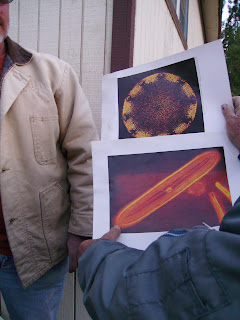Diatoms

One of my favorite creatures in the world, is one that almost no one has ever heard of. In fact, it may not even be a creature, no one really knows whether they should consider it a creature or a plant. I'm talking about diatoms.
Diatoms are tiny, single-celled organisms that are shown in the picture to the right and are extremely important to our world. They live in the ocean, lakes, streams, and wet spots and produce much of the oxygen that we breathe. Prehistoric diatoms also produced much of our fossil fuels as well. Their benefits to the world don't end there either.
Millions of years ago, in the Pliocene and Pleistocene, diatoms flourished. Great inland seas were everywhere, and the diatoms took advantage of the expanded range by breeding prolifically. As they died, their shells settled to the bottom. Over time, the diatom shells built up into layers hundreds or thousands of feet thick. These layers compressed into a rock,
 called diatomite, which is mined to produce a material called diatomaceous earth. The picture to the right is that of a diatomite mine.
called diatomite, which is mined to produce a material called diatomaceous earth. The picture to the right is that of a diatomite mine.Diatomaceous earth is used in numerous products, including cake mixes, animal feed, toothpaste, and pool filters. It kills bugs non-chemically, so it's also important to the organic industry. It's not dangerous to people or animals, unless they breath in too much and then it can irritate the lungs, but it does a great job of killing bugs through dehydration. It is considered one of the best desiccants available.
The key to the diatoms' usefulness are their specialized shells, called frustules. Their frustules are made up of silica, so it's almost like the diatoms live in quartz or glass houses. These siliceous shells are covered in tiny spikes that are so small, we large animals can't feel them at all, but they are just the right size to stick bugs and
 viruses. This makes them great for feeding to animals with worms and sprinkling in the garden to get rid of garden pests and using as a natural pest deterrent. It also makes it a great abrasive which makes it useful in toothpaste. The pile of Diatomaceous Earth in the picture is just a small amount from the diatomite mine in the previous picture.
viruses. This makes them great for feeding to animals with worms and sprinkling in the garden to get rid of garden pests and using as a natural pest deterrent. It also makes it a great abrasive which makes it useful in toothpaste. The pile of Diatomaceous Earth in the picture is just a small amount from the diatomite mine in the previous picture.I love diatoms so much, and they're so important to the world that I've decided to share info on them with everyone. I'm making a Squidoo lens called The Wonderful World of Diatoms and another about Diatomaceous Earth, simply called Diatomaceous Earth. I'm hoping I can share my love of these little organisms with everyone that is interested. Here's what I have done already:
The Wonderful World of Diatoms
Diatomaceous Earth
Check them out and let me know what you think so far. I've barely scratched the surface but eventually I hope to really reveal the secrets of the mysterious diatoms.

Very informative and you opened my eyes to something I wouldn't normally think about.
ReplyDeleteThis is great! Diatoms are so important to our survival, but, I hate to admit, I probably haven't thought of them since college!
ReplyDelete